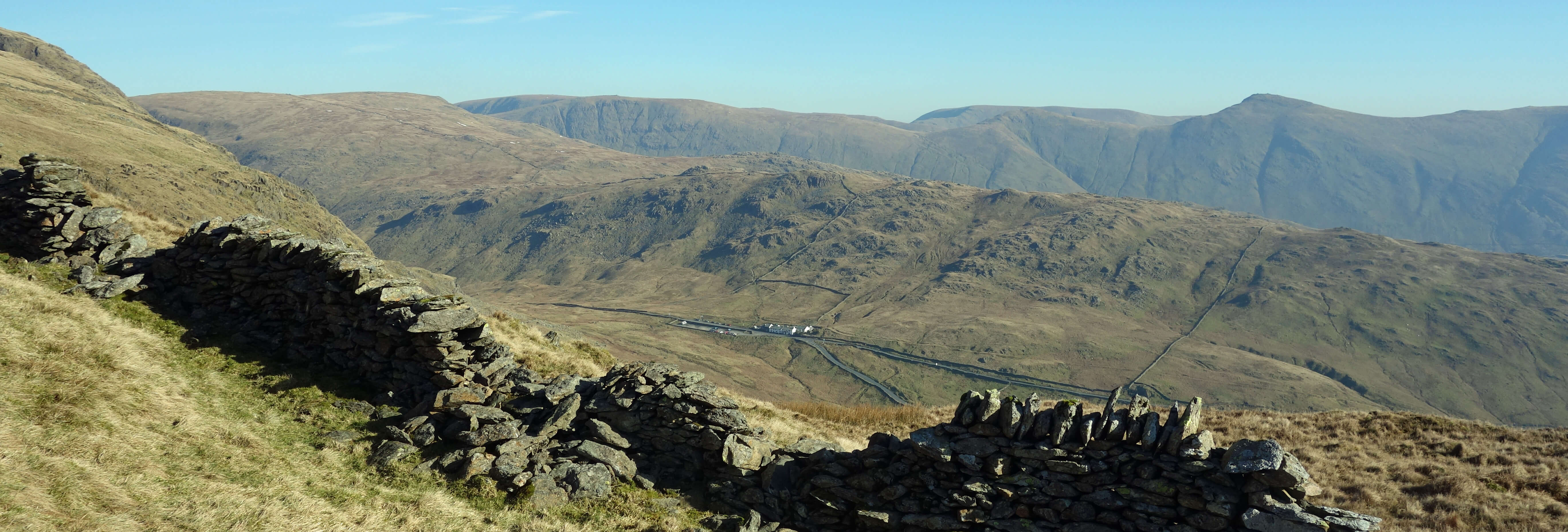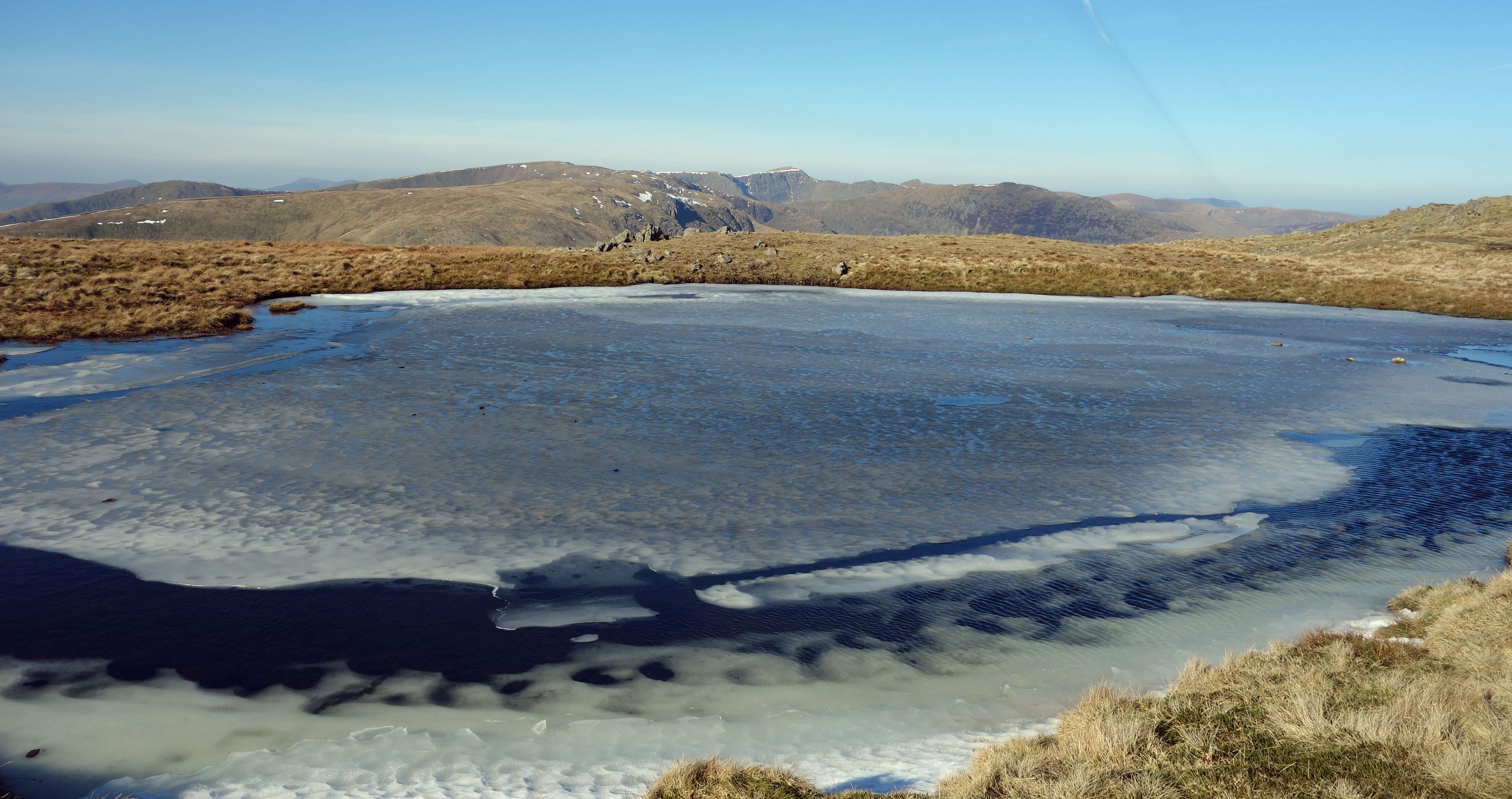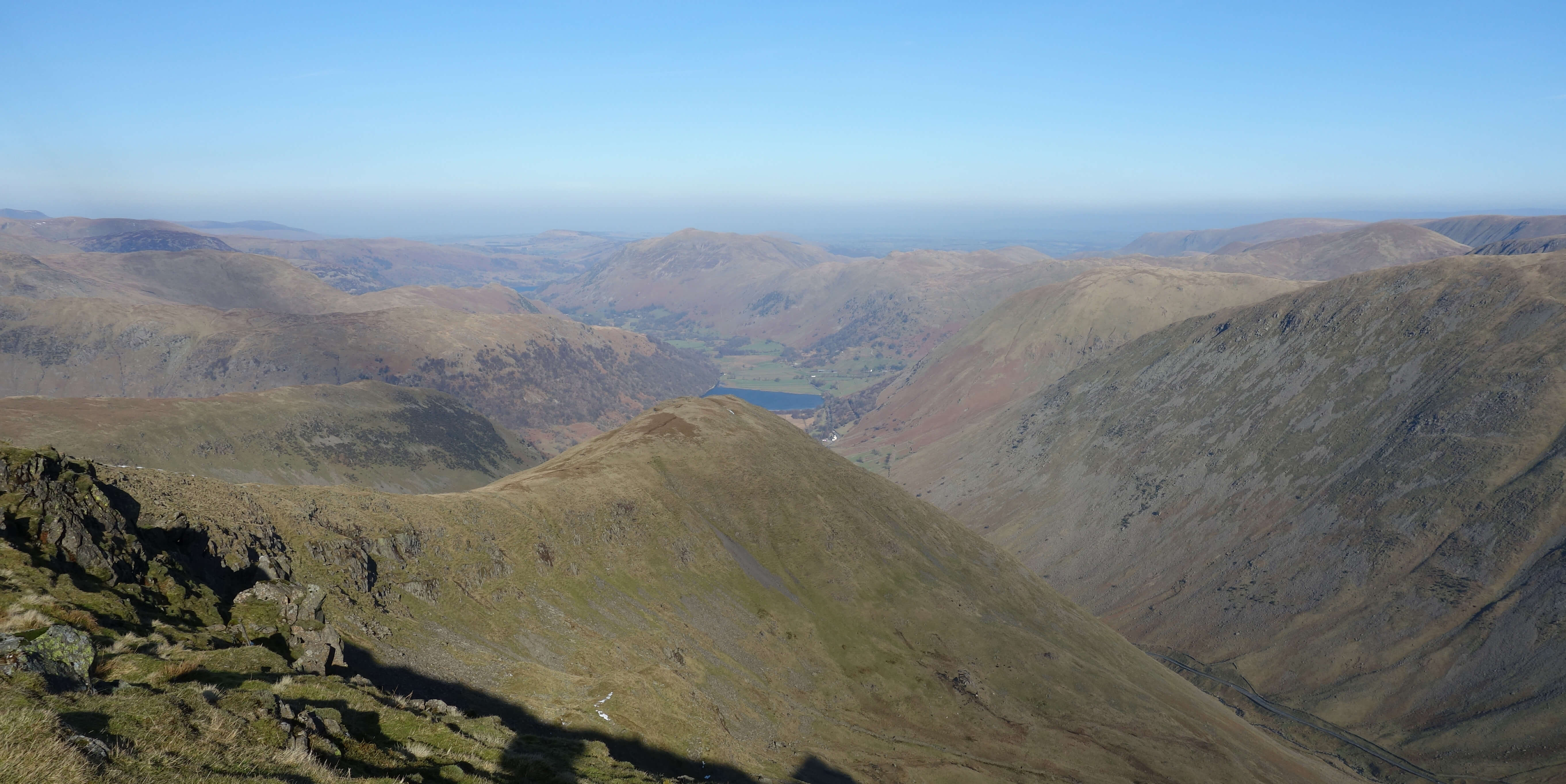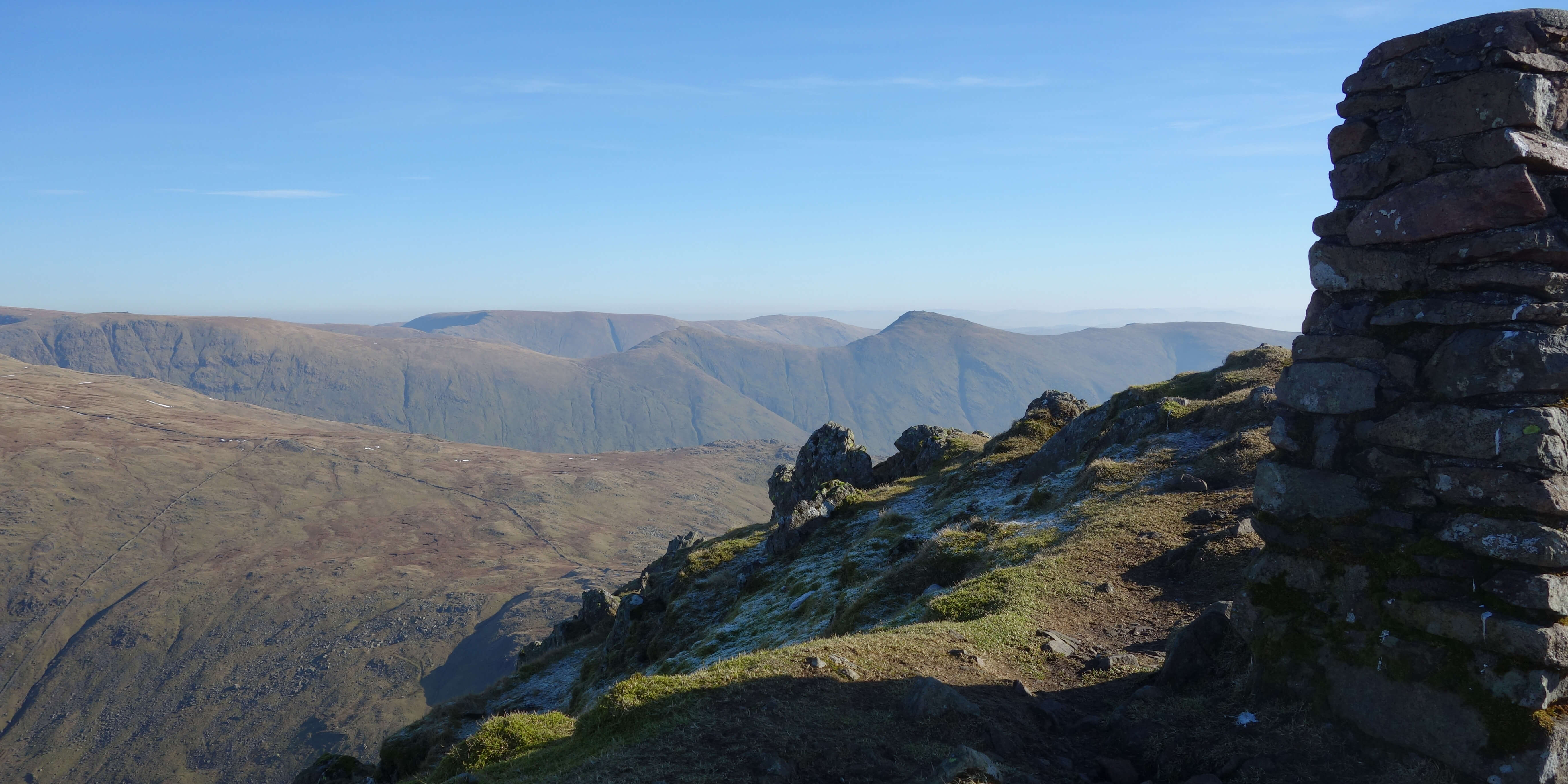
Home
Preamble
Index
Areas
Map
References
Me
Drakkar
Saunterings: Walking in North-West England
Saunterings is a set of reflections based upon walks around the counties of Cumbria, Lancashire and
North Yorkshire in North-West England
(as defined in the Preamble).
Here is a list of all Saunterings so far.
If you'd like to give a comment, correction or update (all are very welcome) or to
be notified by email when a new item is posted - please send an email to johnselfdrakkar@gmail.com.
43. The Red Screes - Wansfell Question
I have a question for members of
The Wainwright Society
(and for anyone else). If I were bagging Wainwrights and walked from Ambleside to Red Screes (776 metres),
returning via the Kirkstone Pass and Wansfell (487 metres), then how many Wainwrights may I tick off?

Kirkstone Pass from the slopes of Red Screes
The walk from Ambleside to the top of Red Screes was as straightforward as a Lake District walk can be. I headed north and kept going. That is not to say that it was easy, as I have not climbed a high hill for a while. However, the slope and the terrain of the ridge that passes Snarker Pike are relatively gentle, and all the while the views are gradually widened. At first I could not see Windermere at all because of low mist but this soon dispersed. The more distant views of Bowfell and Fairfield were a little hazy, perhaps because of the still evaporating snow. By the time that the Red Screes top was at last reached, Helvellyn and High Street had come into view, with a prospect of Brothers Water and a glimpse of Ullswater ahead.

Towards Fairfield and Helvellyn from the little tarn near the top of Red Screes


From Red Screes, looking north and east
The clamber down from Red Screes to the Kirkstone Pass was precipitous and needed to be taken steadily. It was a
bit of a trudge walking south to Wansfell but at least there were good views back towards Red Screes, enabling me to
reflect that I had just walked down that imposing cliff-face. The Ordnance Survey marks the highest point
of Wansfell (487 metres) a mile or so north of Wansfell Pike (482 metres) but it takes some believing. It must be
an optical illusion caused by Wansfell having much higher fells behind (when viewed from the Pike) whereas, from the other direction, Wansfell Pike stands proudly against the sky. Anyway, Wansfell Pike is the better top, with its celebrated view of Windermere.
Now to return to my question. The seven volumes of Wainwright (1955-1966) catalogued 214 fells. Some
walkers set out to bag Wainwrights, that is, to get to the top of some of the 214. Some set themselves the
challenge of getting to the top of all 214 and thereby becoming a ‘Wainwright completer’. They may then
experience the euphoria of
Reinhold Messner:
“Standing now in diffused light, with the wind at my back, I experience suddenly a feeling of completeness – not a feeling of having achieved something or of being stronger than everyone who was ever here before, not a feeling of having arrived at the ultimate point, not a feeling of supremacy. Just a breath of happiness deep inside my mind and my breast” (Messner, 2010). However, Messner, who was the first climber to ascend all fourteen peaks over 8,000 metres, may have been thinking of mountains rather more challenging than, say, Mungrisdale Common, Lank Rigg, Hen Comb or Grike.
Over a thousand walkers have registered as Wainwright completers with The Wainwright Society, and no doubt thousands more are completers without bothering to register the fact. Some walkers complete over and over again, which seems a self-contradiction. The Wainwright Society aims to “keep alive the fell-walking traditions promoted by AW” and is the formal face of what McKay (2012) calls a “vast and curious cult” devoted to the epistles of Wainwright.

Red Screes from Wansfell
However, if a walker so venerates Wainwright that he or she must conquer all his tops then it behoves them to adopt fully the spirit of Wainwright. Wainwright described one or more routes of ascent for each fell. In all, about 750 different ascents are described for the 214 fells. For some fells he mentions one or more ‘ridge routes’ to nearby tops. He leaves the reader to join the pieces. He does not, for example, mention one of the most well-known Lakeland walks, the Kentmere Horseshoe. Instead, he describes the eight tops that constitute the horseshoe in separate chapters. He is like a musicologist who catalogues 214 chords, sometimes says which two chords go well together, but never gives us a melody.
A faithful Wainwright worshipper would reach a top by following a Wainwright route of ascent. In
the case of Wansfell, for example, Wainwright describes two ascents, one from Ambleside and the other from
Troutbeck. He does not describe an ascent from the direction of Red Screes – reasonably enough, because
Wansfell is clearly a descent from Red Screes apart from a small climb at the end. Similarly, a true Wainwright believer would not claim eight Wainwright tops after walking the Kentmere Horseshoe because only one of the tops is ascended by a Wainwright route of ascent.
When a walker has become a true-completer (that is, has walked to the 214 tops following
a Wainwright route of ascent), there is no need to stop there. They can then set out to become a super-true-completer by walking all 750 or so ascents. Do you think anybody
has, apart from Wainwright? It may be sacrilegious to say so but I wonder if Wainwright did. If you rule out all the weekends that are too wet, windy, cloudy or icy (and there are plenty of those) then there are hardly enough weekends left in his thirteen years of travail for 750 ascents. Also, it is possible to descend (like I did from Red Screes to the Kirkstone Pass) and imagine it, and later describe it, as an ascent. So, come on you members of this curious cult, become a super-true-completer, perhaps the first ever!
Just to be clear, I’m not against challenges: I’ve set myself a few in the past. A challenge adds
interest, provides motivation and, ultimately, a feeling of achievement, although it may also become
an obsession. The challenge that I half-heartedly raised in the
Preamble
– that is, to visit
every one of the 400 5 km x 5 km squares of my North-West England – remains half-hearted.
As it happens, I’ve visited 100 of them since I started Saunterings in January 2018.
Date: February 15th 2019
Start: NY373042, Ambleside (Map: OL7)
Route: N, NE on Kirkstone Road, N on track (above Roundhill Farm) –
Snarker Pike, Red Screes – SE – Kirkstone Pass – S, SE – Woundale Raise – S –
Baystones – SW – Wansfell Pike – W - Ambleside
Distance: 9 miles; Ascent: 730 metres
Home
Preamble
Index
Areas
Map
References
Me
Drakkar
© John Self, Drakkar Press, 2018-

Top photo: The western Howgills from Dillicar;
Bottom photo: Blencathra from Great Mell Fell







